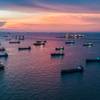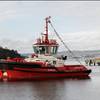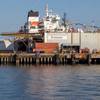According to a Medaia News, Sheets of decayed metals, hull coatings and lead paint more than one-third of an inch thick peeled off two obsolete U.S. Maritime Administration ships when marine growth was scrubbed from their hulls at the Port of Richmond last month, according to a report prepared for the federal government.
The toxic material was left in San Francisco Bay, much of it adhered to thick seaweed and barnacles that accumulated on the ships for more than 35 years as they were anchored in the Suisun Bay Reserve Fleet near Benicia.
When the cleaning was done in early August, MarAd said only organic materials would be left in the water.
But the report prepared for the administration states, "marine growth across the flat bottom of the hull appeared to peel away in pieces up to several square feet at a time adhered to sections of corroded steel flakes. ... Corroded metal and old flakes ... appeared to maintain a consistent maximum thickness of approximately .375 (of an) inch.
"These flakes seemed to be made up of tightly bound marine fouling over brittle advanced corrosion wastage and aged hull coating," states the report, prepared by employees of the company that did the work, Underwater Resources Inc. of San Francisco.
The Coast Guard also released photographs of the ships, showing the badly rusted hulls with paint chipping away in large sections and thick grasses visible below the waterline. The photos also show the large chips of decayed metals described in the report.
Lead paint dissolving in the Bay represents the most immediate environmental threat, said a ship disposal expert and chemical engineer. The Maritime Administration did not know about material entering the water until it received the contractor's report, its spokeswomen Shannon Russell said in an e-mail Thursday. She did not answer a question about who from the administration monitored
the work or why it wasn't halted when it became obvious the metals were peeling from the ship.
An environmentalist familiar with the ships said MarAd lacks credibility when it comes to protecting local waters.
The work was done under a Coast Guard order issued in late June that requires ships leaving the administration's three reserve fleets to have their hulls cleaned of marine growth that could be transported to areas of the world where it is not native. The program is designed to slow the spread of invasive species.
Three World War II Victory ships were cleaned last month under the Coast Guard order — two in Richmond, one in Alameda — before being towed to Brownsville, Texas, to be cut up for scrap.
Each ship was 439 ft. long with a beam of 63 ft. at its widest point. At Richmond, the materials were removed from 90 percent of the underwater portion of their hulls, the report states. There was no report immediately available on the work done in Alameda.
Growth on the ships was so heavy that divers quickly wore down the nylon scrubbers they were using and had to order more, the report states. They also used hand scrapers to remove some of it, the document states.
Under the Coast Guard order, hand scrappers were to be used only on the ships' propellers because of concerns that hand scrapping would rip away hull materials.
Separate Maritime Administration ship condition reports prepared recently for the three Victory ships cleaned in Richmond and Alameda describe them as being badly corroded, their decks covered with paint chips and their holds filling with what was described as oily water.
The Coast Guard approved all three for towing to Texas, although one of the them, the Barnard Victory, failed its initial inspection and needed additional work to make it safe for towing.
Source: Media News
Sponsored Content
Innovative Hull Maintenance: Profitable & Green

Subscribe for
Maritime Reporter E-News
Maritime Reporter E-News is the maritime industry's largest circulation and most authoritative ENews Service, delivered to your Email five times per week












